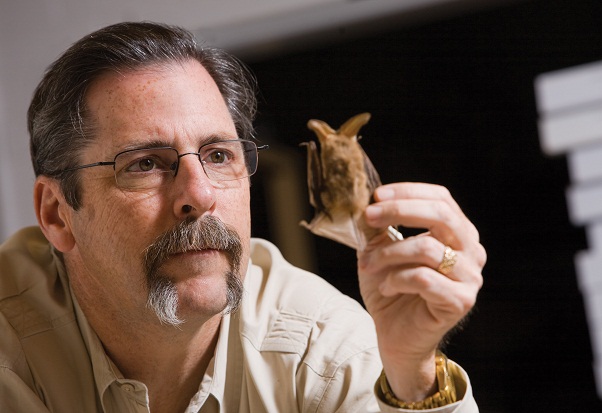Beyond Gotham City
Thursday, January 27, 2011

Photos by Gary Lawson
Zoologist Ron Van Den Bussche teaches his graduate students they need to get out of
their labs and hoof it into the wilderness to understand the species they study.
From the Amazon rainforest to the doorstep of Chernobyl’s Reactor No. 4, the College
of Arts and Sciences associate dean for research has practiced what he preaches. He
has studied small mammals in Texas, Oklahoma, Honduras, Siberia, Poland and the exclusion
zone surrounding the world’s worst nuclear accident. That, as well as his more than
100 published articles, is part of why last year he became one of the college’s three
new Regents Professors for 2009.
Balancing research with teaching and administrating is a lot like working two full-time
jobs, Van Den Bussche says. Yet he enjoys being an administrator, helping fellow professors
get funding for their work while also keeping up his own research.
Much of his work deals with bats, which he says make up one-fourth of the world’s
more than 4,000 species of mammals. That means he often ends up bending his lanky,
6-foot 3-inch frame into caves, attics, rotted trees and other dark nooks and crannies
in nearly every climate in the world.
“The evolution that’s had to happen with these animals is just fascinating,” he says.
“We’ve got solitary bats. We have bats that form harems. Anything you can think of
happens in bats. Look at vampire bats. If they don’t have a meal in three days, they’ll
die. So if somebody hasn’t had a meal, somebody else will regurgitate its blood meal
for it. They’re very social animals.”
Van Den Bussche has a host of grants looking into the animals’ mysteries, as well
as those of other small mammals. One included a Fulbright Fellowship that sent him
to the Polish Academy of Sciences’ Museum and Institute of Zoology in Warsaw where
he set up a lab that specializes in ancient DNA and got the chance of a lifetime to
work with some rare bat fossils.
When bats die, they decay too quickly in most climates to form fossils due to their
small, delicate bodies and the effects of moisture. That makes the animals’ fossil
record spare and adds to their mystery. However, the bat cave in the Caucasus was
dry — prime for fossilized remains.
“We pulled out these dead bats, and initially we thought they were ones that had just
died. When we carbon-dated them, we found they were about 5,000 years old. They were
preserved that well.”
It was part of an effort to resolve a long-running controversy over whether two types
of bats that used the cave, both termed the lesser mouse-eared bat, were different
species or subspecies. Using DNA from a ground-up tooth, researchers determined the
animals were very similar genetically, but their reproduction and feeding habits differed
significantly, indicating they may be different species.
Earlier in his career, his studies of genetic changes in rodents collected in the
exclusion zone surrounding the Chernobyl nuclear plant ended up in the journal, Nature,
in 1996, one year after he started at OSU.
The power plant’s meltdown and explosion in 1986 contaminated thousands of square
miles, rendering the region uninhabitable to humans and making it a prime location
to study how wildlife recovers after a nuclear accident.
Braving enough radiation to fry a Geiger counter, Van Den Bussche made his first trip
to the burnt-out plant and the abandoned nearby city of Pripyat, Ukraine, in 1992
while finishing his postdoctoral work at the University of Idaho.
“When I first started going over there, there were tons of rats, but around 1997 or
1998, wolves, moose and Russian wild boar became a problem. They were destroying our
traps. We were seeing them all over the place. In this big enclosed area where humans
will never live again, the animals are doing great. That showed me that humans are
far worse on animals than radiation.”
Although he doesn’t make any more trips to Chernobyl, he says he’ll continue his research
into small mammals while also joining his wife, fellow zoologist Meredith Hamilton,
on research trips to the jungles of Honduras with their graduate students.
Van Den Bussche holds a doctoral degree in zoology from Texas Tech University, a master’s
degree in biology from Memphis State and a bachelor’s degree in wildlife management
from Eastern Kentucky. He is a winner of the Southwestern Association of Naturalists
Donald W. Tinkle Research Excellence Award and the OSU College of Arts and Sciences
Outstanding Professor Award.
This story originally ran in the 2010 College of Arts & Sciences magazine.
